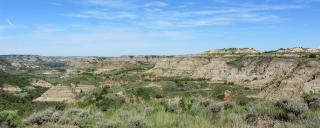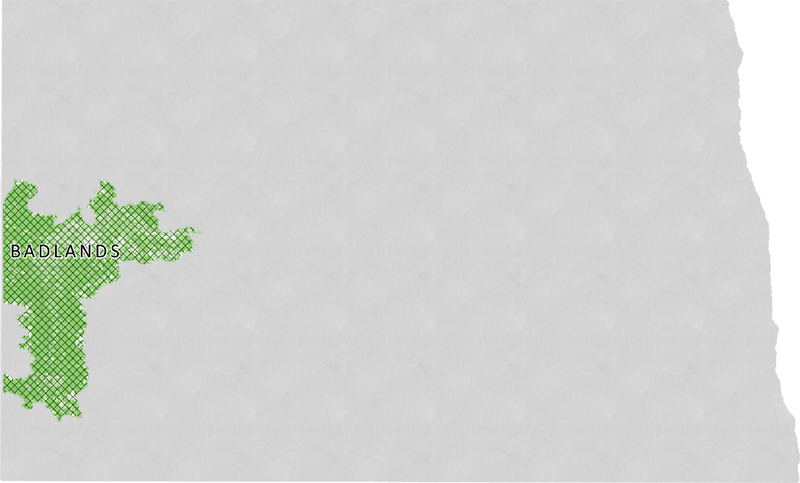

Badlands
Area: 2,862,000 acres
Public Landholdings: 838,670 acres (NDGFD 7,895 acres; NDDTL 126,790 acres; NDPRD 4,770 acres; USFWS 1,290 acres; USFS 602,535 acres; USNPS 69,770 acres; USBLM 17,780 acres; USACE 7,840 acres)
Description and Overall Condition:
This landscape component includes the area associated with the Little Missouri River (see Figure 25) drainage and is commonly referred to as badlands. This highly dissected landscape was formed by water erosion of the soft silt or clay soil and collapse following lignite coal bed burnings. Badly eroded clay-scoria slopes, buttes, and steep canyons are common throughout.
Thickets of small trees and shrubs or woody draws of cottonwood and green ash naturally occur on north or east facing escarpments. Bare hills with scattered Rocky Mountain juniper, and shortgrass prairie in the bottomland and on top of buttes occur throughout. A few small, unique stands of native coniferous forest are present, specifically in Billings, Golden Valley, Slope and Bowman counties. The lack of fire has allowed the expansion and encroachment of juniper in some areas. Ephemeral or intermittent streams are common in steep valleys. Natural wetlands are rare but water impoundments are common. Cattle grazing is prevalent and the most common land use. Recreation, and oil and gas activity are intensifying. The badlands are becoming extremely fragmented with the escalating number of roads required for industrial development. The US Forest Services owns and manages about 1 million of acres as multiple-use in this landscape. The Killdeer Mountains and Ponderosa Pines Focus Areas are located within the exterior boundaries of the Badlands, but included in Upland Forest (see Figures 38 and 39). The Badlands are a fragile landscape harboring many unique wildlife species in addition to the SCP. The entire landscape could be considered a Focus Area.
Predominant Natural Vegetation
Grasses/Shurbs/Trees
cottonwood, green ash, Rocky Mountain juniper, Ponderosa pine, limber pine, bur oak, dwarf juniper, creeping juniper, spiny saltbrush, greasewood, prickly pear, rabbitbrush, silver sage, Western wheatgrass, blue grama, little bluestem, prairie sandreed, ricegrass, bluebunch wheatgrass, Indian ricegrass
Forbs
yucca, fern, winter fat (TRNP), golden eriogonum, large-flowered dock, butte primrose, standing milkvetch, penstemon, purple coneflower, long-headed coneflower
Associated Species of Conservation Priority
Birds
ferruginous hawk, golden eagle, *peregrine falcon, prairie falcon, sharp-tailed grouse, long-billed curlew, burrowing owl, black-billed cuckoo, sprague’s pipit, loggerhead shrike, lark bunting, grasshopper sparrow, baird’s sparrow, chestnut-collared longspur, western meadowlark
Mammals
merriam’s shrew, northern long-eared bat, western small-footed bat, long-eared bat, long-legged bat, little brown bat, big brown bat, townsend’s big-eared bat, sagebrush vole, black-tailed prairie dog, black-footed ferret, swift fox
Reptiles/Amphibians
plains spadefoot, short-horned lizard, sagebrush lizard, plains hog-nosed snake
Insects
monarch butterfly
Other Characteristic Wildlife
Birds
turkey vulture, red-tailed hawk, sharp-shinned hawk, Cooper’s hawk, Northern goshawk, American kestrel, merlin, ring-necked pheasant, wild turkey, great horned owl, long-eared owl, boreal owl, Northern saw-whet owl, rock dove, mourning dove, common nighthawk, common poorwill, downy woodpecker, hairy woodpecker, Northern flicker, Clark’s nutcracker, least flycatcher, say’s phoebe, Western kingbird, Eastern kingbird, black-billed magpie, American crow, common raven, horned lark, tree swallow, Northern rough-winged swallow, cliff swallow, barn swallow, violet-green swallow, black-capped chickadee, red-breasted nuthatch, white-breasted nuthatch, brown creeper, house wren, rock wren, golden-crowned kinglet, ruby-crowned kinglet, mountain bluebird, American robin, gray catbird, brown thrasher, townsend’s solitaire, gray- cheeked thrush, Bohemian waxwing, cedar waxwing, yellow warbler, yellow-rumped warbler (Audubon’s), black-and-white warbler, American redstart, ovenbird, pine warbler, blackpoll warbler, common yellowthroat, yellow-breasted chat, spotted towhee, chipping sparrow, clay- colored sparrow, field sparrow, vesper sparrow, lark sparrow, lazuli bunting, pine grosbeak, red crossbill, white-winged crossbill, evening grosbeak, Western meadowlark
Mammals
desert cottontail, mountain cottontail, Northern myotis, least chipmunk, bushy-tailed woodrat, bighorn sheep, elk, mule deer, white-tailed deer, pronghorn
Reptiles/Amphibians
Woodhouse’s toad, Great Plains toad, Northern leopard frog, common garter snake, plains garter snake, bullsnake, yellowbelly racer, prairie rattlesnake
For more detailed information about this topic, please see the North Dakota Wildlife Action Plan.

